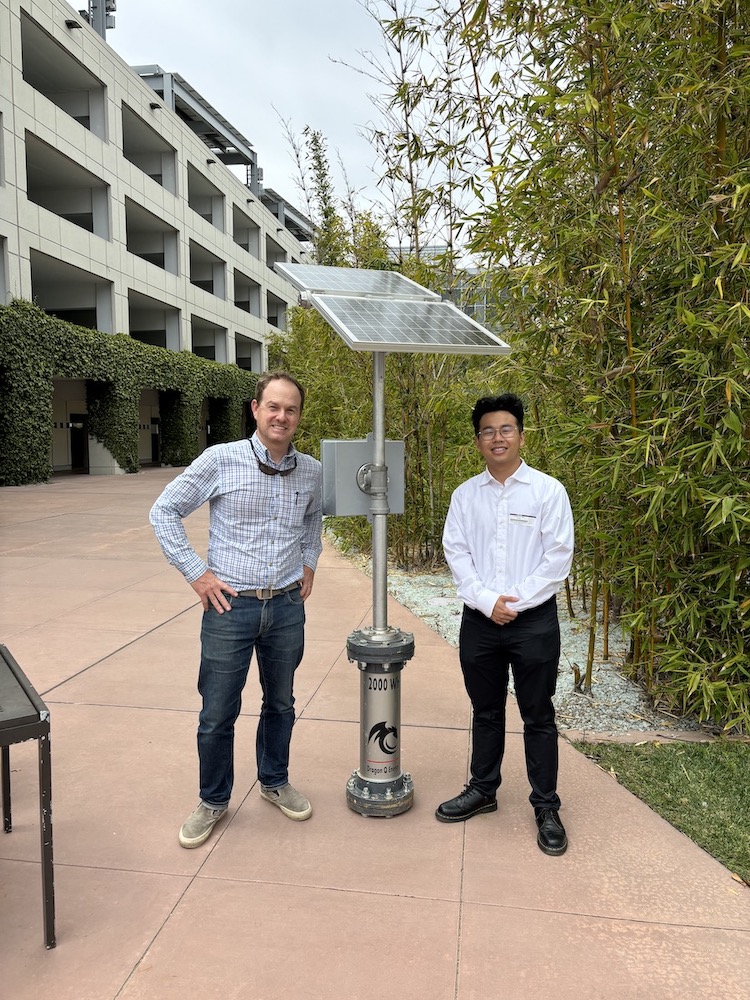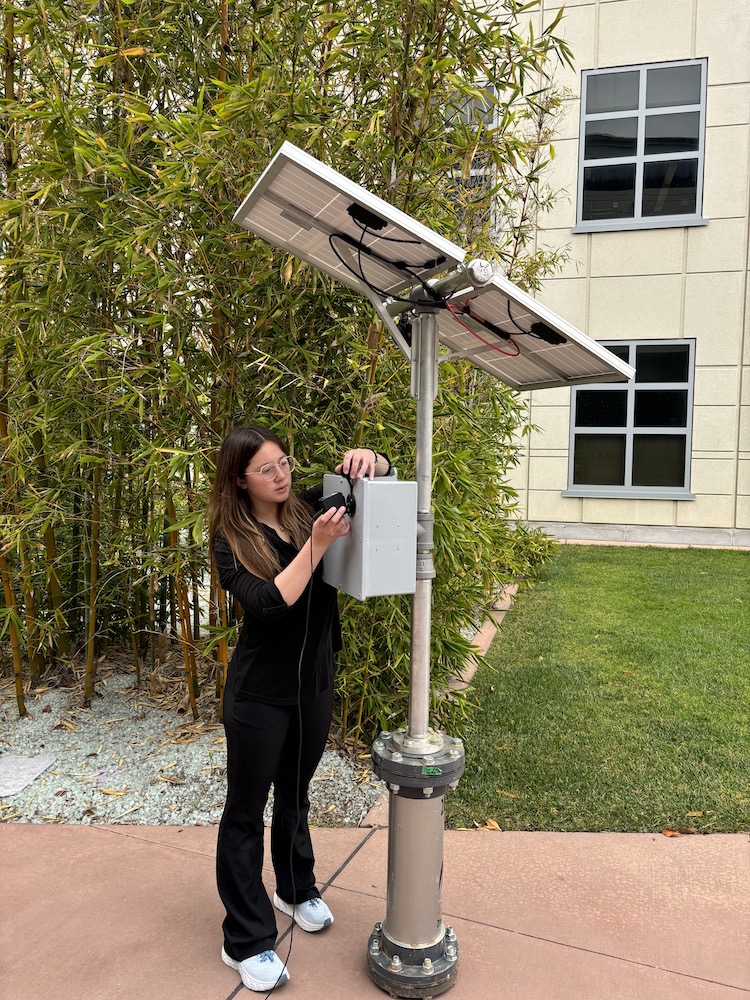Dragon Q Energy & California NanoSystems Institute at UCSB

At UCSB, the California NanoSystems Institute (CNSI) is a Technology Incubator Lab in Elings Hall. The Incubator has 1,500 square feet with wet bench lab space and office space available for lease by local tech start-ups. Its location near the CNSI Shared Experimental Facilities, the Materials Characterization Facilities, as well as conference rooms and meeting spaces, encourages successful engagement and innovation. Incubator companies benefit from UCSB’s entrepreneurial mentorship and training ecosystem, and the vibrant research community of CNSI. Heading the Incubator is Tal Margalith, Executive Director of Scientific Initiatives and Innovation.
One of the start-ups, Dragon Q Energy(DQE), leased space there to develop a new way to build safe and scalable grid-sized battery energy storage systems (BESS). Their team includes founder Dan Casey, mechanical engineer Quang Bui, electrical engineer Eliana Petreikis, and marketing director Liam Casey. Their product is an off-grid, solar integrated power system called the PowerPole, which places the battery portion underground and yields 15kWh of energy per unit. They are designating it for communities in need of electrical power.
DQE received a grant from the UCSB Bren School of Environmental Sciences and Management, and is partnered with Unite to Light, a nonprofit foundation. DQE asserts they are a mission-based company that will manufacture and design products, not a foundation or nonprofit organization.
They reached out to me regarding their product, and their need to obtain further funding to complete it. Due to the team’s various schedules, we opted for an email interview for the details.
Q.How did you get to the CNSI Incubator Lab?
A. This is the exceptional part about CNSI, they accept professor spinouts, student and alum lead start-ups, and Santa Barbara-based startups. We interviewed with the directors of CNSI about 18 months ago and they extended DQE a lease on lab, workshop, and office space. A few weeks ago, we relocated to the Capella Ventures & CNSI Flight Deck. The Flight Deck is a collaboration with CNSI and is used as a steppingstone for later-stage start-ups to expand with more workspace. There are four CNSI incubated startups here. The Flight Deck was instrumental in DQE securing a reasonably priced workspace in the competitive and expensive SB real estate market. We still have access to UCSB facilities, equipment, internships, and grants.
And the Bren School Grant…
We applied for the Bren/CNSI innovator grant on May 20th and received our proposal acceptance on June 19. The timeline for the use of the grant runs from Q3 2024 to Q2 2025. The funds came down from the State of California. We applied for and received the $50,000 Proof of Concept after demonstrating thorough customer and user discovery, and a plan for a community project. The use of funds will help finalize engineering and build three minimum viable product (MVP) units for community pilot projects with Unite to Light.
How does the PowerPole provide electricity?

I think it’s important to note that this will not create a “grid.” The PowerPole provides direct electricity to the end user without a complicated grid. Users can either directly plug into the PowerPole via a series of outlets (that can be customized based on region and need) or the PowerPole can be connected to a building by a skilled electrician. For the first few PowerPole installations we expect to send a DQE staff person to complete the install. Long term, we intend to create a step-by-step manual so that any electrician can install the system and perform maintenance. We will, of course, follow any and all building codes and regulations as required by local governments.
After the sale of the PowerPole units, we will take on the responsibility of ensuring local stakeholders are trained to manage and maintain the PowerPole units. Working with organizations such as Engineers Without Borders will allow for training programs and repair manuals to be developed to increase system reliability, sustainability and empower local expertise. Additionally, customers will have the option to buy replacement parts for the PowerPole directly from an inventory of parts maintained around the continent by Dragon Q Energy and our suppliers.
Where are you in terms of R & D?
We like to say we’re in development mode, or the D part of R and D. We have a field deployed prototype, which we are collecting data on. Investors don’t like funding for research in our experience. In the remainder of 2024 and into 2025, we will complete the experimental design, design for the manufacturer, and conduct the experiments to validate our safety and efficiency claims. We will move from a technical readiness level (TRL) of 5 to 8. Our punch list of items to get an MVP are all engineering problems at this point.
Have you addressed battery storage underground as a contaminant of the soil and water supplies, and the use of argon in your product?
Our battery containers are designed and built to readily adopted standards and specifications (ASME and ASTM) for pressurized vessels and the battery packs will be sold in compliance/certified in accordance with UL and UN rules for shipping and use to ensure the safest battery systems for our customers
Argon is an inert non-hazardous gas that poses virtually no danger to the environment or soil as utilized in this application. Our systems will generally be used outdoors and in low volumes that greatly reduce or eliminate any risk.
Furthermore, our container offers double containment of the battery cell chemistry, and when installed in the field, we can provide a tertiary (3rd way) method to contain cell chemistry and prevent it from escaping. Our differentiated approach is also chemistry agnostic (beyond Li-ion) and we are going to market with a Nickel Metal Hydride (NiMH) cell offering. Toyota famously used, and still uses, NiMH cells in many of its hybrid vehicles. The electrolyte is water based, materials are non-toxic, and simpler for our customers to use from a logistics and shipping standpoint.
What is your ask for investors?
This is our pre-seed raise, and we’re looking for strategic partner alignment and $750,000 from various investors. We have a firm commitment from one investor, a soft commitment on zero-interest loan as a follow-on from a previous grant fund, and a similar soft commitment for funds for community pilot projects with Unite to Light. We’d like to emphasize that the Montecito Journal reader base can help DQE on our mission to empower people and communities who lack electricity.





